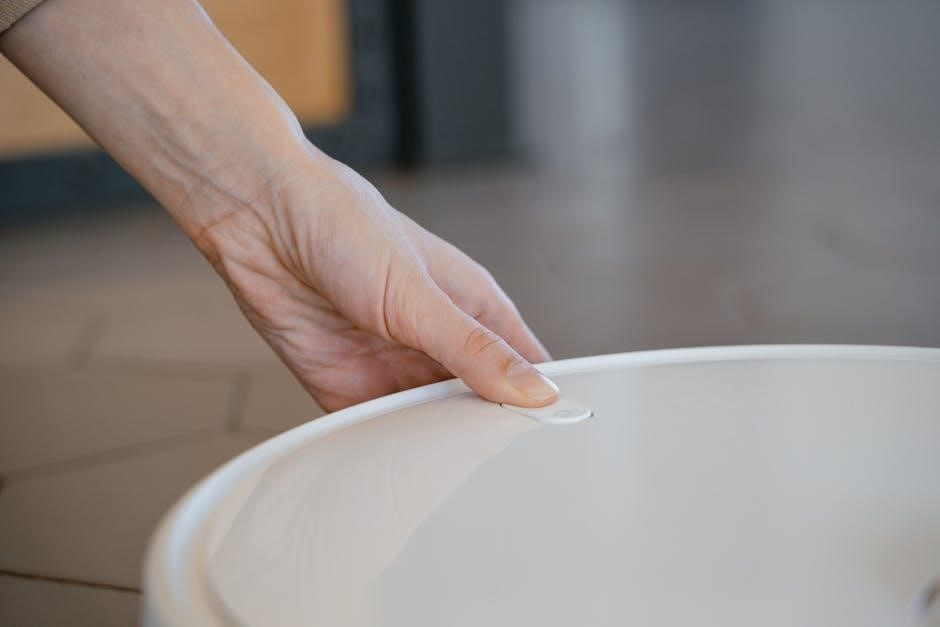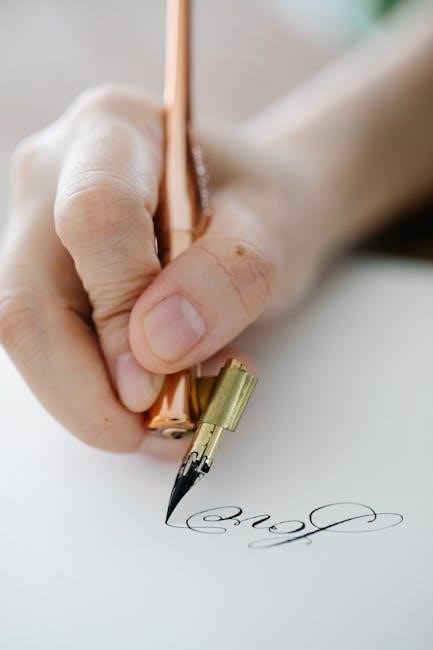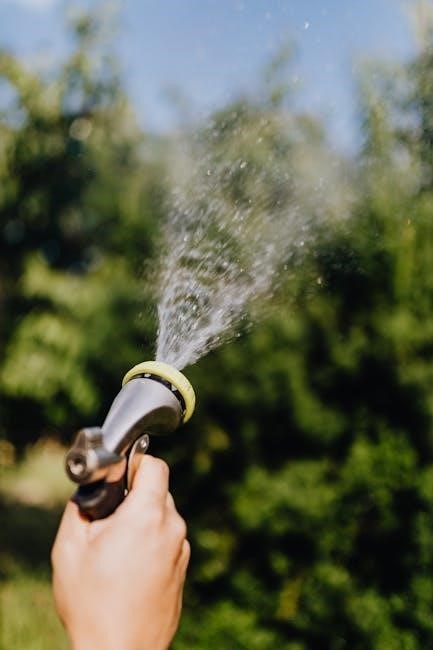Manual pool vacuuming is essential for maintaining clean and clear water. It involves using a vacuum head, hose, and pole to remove debris effectively, ensuring optimal pool health and clarity.
Understanding the Importance of Manual Pool Vacuuming
Manual pool vacuuming is a crucial maintenance task for keeping your pool clean and hygienic. It effectively removes debris, dirt, and algae from the pool floor, ensuring clear water and preventing damage to pool equipment. Regular vacuuming helps maintain the pool’s aesthetic appeal and promotes a healthy swimming environment. Unlike automatic cleaners, manual vacuuming allows precise control, making it ideal for tackling stubborn debris. It also complements the pool’s filtration system by removing contaminants that the filter may miss. Consistent manual vacuuming prevents algae buildup and prolongs the pool’s surface life, saving time and money in the long run. It is an essential step in maintaining a well-maintained and enjoyable swimming pool.
Overview of Manual Pool Vacuum Components
A manual pool vacuum system consists of a few key components designed to work together for effective cleaning. The vacuum head is the part that contacts the pool floor, typically fitted with brushes or wheels to glide smoothly over different surfaces. The telescoping pole provides adjustable length, allowing easy reach across the pool without strain. The vacuum hose connects the vacuum head to the pool’s skimmer or dedicated vacuum port, channeling debris into the filtration system. Together, these components enable efficient removal of dirt and debris, ensuring a clean and well-maintained pool environment. Understanding each part is essential for proper assembly and use, maximizing the effectiveness of the vacuuming process.

Preparation for Using a Manual Pool Vacuum
Gather all necessary equipment, ensure the pool is free of large debris, and check the vacuum components for proper function before starting the cleaning process.
Gathering Essential Equipment
To effectively use a manual pool vacuum, you need a few key pieces of equipment. First, ensure you have a sturdy telescoping pole that can reach all areas of the pool. Next, gather a vacuum head designed for your pool surface type, such as concrete, vinyl, or fiberglass. A vacuum hose long enough to cover the pool’s length is also necessary. Don’t forget connectors or adapters to secure the hose to the vacuum head and pool skimmer. Additional items like pool skimmer baskets and brushes can aid in removing debris before vacuuming. Always inspect equipment for damage or leaks to ensure proper function during the cleaning process.
Understanding the Pool Vacuum Setup
Understanding the components and their connections is crucial for effective manual pool vacuuming. The telescoping pole serves as the base, allowing you to maneuver the vacuum head without entering the pool. The vacuum head, attached to the pole, is designed to glide over the pool floor, collecting debris. The vacuum hose connects the vacuum head to the pool’s skimmer or dedicated vacuum port, creating suction. Proper alignment and secure connections ensure optimal suction power, while the pool pump and filter work in tandem to circulate clean water. Familiarizing yourself with these elements ensures a smooth and efficient cleaning process, keeping your pool water crystal clear and debris-free.
Checking Pool Conditions Before Vacuuming
Before vacuuming, it’s essential to assess the pool’s condition to ensure effective cleaning; Check the water level to ensure it’s adequate for proper suction. Inspect the pool floor for large debris that may clog the vacuum. Clear any floating debris using a skimmer to prevent it from sinking and complicating the vacuuming process. Ensure the pool pump and filter are running to maintain water circulation. Examine the vacuum setup for any damage or blockages, especially the hose and vacuum head. Verify that the skimmer basket is clean to avoid restricting suction power. Finally, ensure the vacuum head is suitable for your pool’s surface type, whether concrete, fiberglass, or vinyl, to prevent damage and ensure efficient cleaning.

Step-by-Step Guide to Using a Manual Pool Vacuum
Attach the vacuum head to the telescoping pole, connect the hose, and submerge it in the pool. Remove air from the hose, then connect it to the skimmer or vacuum port to begin cleaning.
Attaching the Vacuum Head to the Telescoping Pole
Start by securing the vacuum head to the telescoping pole. Ensure the connection is tight using screws or clips provided. This ensures stability while vacuuming. Next, test the attachment by gently tugging on the vacuum head to confirm it’s firmly in place. A loose connection can lead to inefficiency or damage. Align the vacuum head with the pole’s end to maintain proper balance. Once attached, the vacuum head should move smoothly across the pool floor without wobbling. Proper attachment is crucial for effective cleaning and prevents accidents. Always ensure compatibility between the vacuum head and pole for optimal performance.
Connecting the Vacuum Hose to the Vacuum Head
Attach one end of the vacuum hose to the vacuum head, ensuring a secure connection. Most hoses click or screw into place. Check compatibility to avoid leaks or poor suction. Tighten any connections if necessary. Once connected, submerge the hose and head into the pool. Hold the hose underwater to fill it, eliminating air bubbles. This ensures proper suction. If the hose floats, guide it gently until fully submerged. A secure connection prevents air leaks, maximizing cleaning efficiency. Always test the connection before vacuuming to avoid interruptions. Properly attaching the hose is critical for effective pool cleaning. Ensure the hose is free of kinks for smooth water flow and consistent suction power.
Submerging the Vacuum Head and Hose into the Pool
Gently lower the vacuum head and hose into the pool, ensuring they are fully submerged. Hold the hose underwater to fill it completely, which removes air and enhances suction. Avoid allowing the hose to float or kink, as this can disrupt the vacuum’s efficiency. Once submerged, guide the vacuum head across the pool floor using slow, deliberate movements. This step is crucial for effective debris removal. Proper submersion ensures consistent suction power and thorough cleaning. Always maintain control of the hose to prevent tangling or twisting. Submerging correctly helps in achieving a cleaner pool with minimal effort. Ensure the vacuum head glides smoothly over the pool surface for optimal results.
Eliminating Air from the Vacuum Hose
To ensure proper suction, remove all air from the vacuum hose. Submerge the hose fully underwater, holding one end below the surface. Gently shake or push the hose to force air bubbles out. Once water flows steadily from the other end, the hose is air-free. This step is crucial for maintaining consistent suction power. If air remains, it can reduce vacuum efficiency and leave debris behind. After eliminating air, connect the hose to the pool skimmer or vacuum port. Properly purging the hose ensures effective cleaning and prevents clogging. Always check for air pockets before proceeding to vacuum the pool floor. This simple step enhances the overall cleaning process and keeps your pool spotless. Regularly removing air ensures optimal performance of your manual pool vacuum.
Connecting the Hose to the Pool Skimmer or Dedicated Vacuum Port
Once the vacuum head and hose are submerged, attach the free end of the hose to the pool skimmer or dedicated vacuum port. Ensure the connection is secure to maintain proper suction. Turn on the pool pump to activate the vacuum system. Adjust the pump’s suction power as needed for optimal cleaning. If using a skimmer, direct the debris flow into the skimmer basket. For a dedicated port, ensure it is set to “vacuum” mode. Properly connecting the hose ensures efficient debris removal and prevents clogging. Always check the connection for tightness to avoid losing suction. This step is vital for effective pool cleaning and maintaining water clarity. Secure connections ensure the vacuum operates smoothly and efficiently, making the cleaning process faster and more effective. Regular checks help maintain consistent performance during vacuuming sessions.

Techniques for Effective Pool Vacuuming
Use long, slow strokes, starting from the shallow end and moving to the deep end. Overlap strokes to ensure thorough coverage and prevent missing debris.
Starting at the Shallow End and Moving to the Deep End
Begin vacuuming at the shallow end of the pool and gradually work your way toward the deep end; This method prevents debris from resettling and ensures efficient cleaning. By starting shallow, you allow debris to be guided toward the deep end, where it can be more easily vacuumed. Use slow, overlapping strokes to cover the entire pool floor, ensuring no spots are missed. This technique helps maintain water clarity and prevents debris from circulating back into the pool. Always work in sections, moving systematically to avoid missing areas. This approach ensures a thorough and effective cleaning process, leaving your pool floor spotless and debris-free.
Using Long, Slow, and Overlapping Strokes
When vacuuming your pool, use long, slow, and overlapping strokes to ensure thorough cleaning. This technique prevents debris from being stirred up and helps cover the entire pool floor evenly. By moving the vacuum head in steady, deliberate motions, you can effectively pick up dirt and leaves without spreading them around. Overlapping strokes ensure no areas are missed, especially in corners and along edges. Slow movements allow the vacuum to suction debris properly, while faster strokes may leave some particles behind. This method is particularly effective for maintaining clear water and preventing debris from resettling after cleaning. Consistency and patience are key to achieving a spotless pool floor with this technique.
Addressing Stubborn Debris and Algae
For stubborn debris and algae, use a pool brush to scrub the area before vacuuming. This loosens particles, making them easier to remove. When encountering thick algae or large debris, adjust the vacuum’s suction power or use a smaller nozzle for precision. For particularly tough spots, manually remove large particles with a leaf skimmer first. Algae can be challenging, so ensure the vacuum head is designed for your pool’s surface. Regular vacuuming helps prevent algae buildup, but persistent issues may require additional treatments. Always clean the vacuum head after tackling stubborn debris to maintain efficiency. Consistent effort ensures a clean, algae-free pool floor, enhancing overall water clarity and swimming comfort. Regular maintenance is key to avoiding future challenges with debris and algae.

Maintenance and Care During Vacuuming
Regularly monitor and adjust suction power, clean the vacuum head and hose during use, and empty the skimmer basket to ensure optimal performance and efficiency;
Monitoring and Adjusting Suction Power
Monitoring and adjusting suction power is crucial for effective pool vacuuming. Start by ensuring the pool pump and filter are running smoothly, as they provide the necessary suction. If the vacuum feels weak, check for blockages in the hose or vacuum head. Adjust the pump’s speed to increase or decrease suction as needed. Proper suction power ensures debris is picked up efficiently without stirring the pool floor. Regularly cleaning the skimmer basket and filter also helps maintain consistent suction. Adjusting suction power based on debris type and pool conditions optimizes cleaning results and prevents damage to equipment. This step ensures a cleaner pool with less effort.
Cleaning the Vacuum Head and Hose During Use
Cleaning the vacuum head and hose during use ensures optimal performance and prevents clogs. After submerging the equipment, check the vacuum head for trapped debris, especially leaves or algae. Use your hands or a soft brush to remove any blockages. For the hose, inspect for kinks or twists that may restrict water flow. If suction power decreases, lift the hose slightly to allow air bubbles to escape, then submerge it again. Regularly rinsing the vacuum head with clean water helps maintain its effectiveness. Keeping the equipment clean during use prevents interruptions and ensures a thorough pool cleaning session. This maintenance step is vital for achieving a spotless pool floor and a well-functioning vacuum system.
Emptying the Pool Skimmer Basket Regularly
Emptying the pool skimmer basket regularly is crucial for maintaining efficient suction and ensuring the manual pool vacuum operates effectively. Debris like leaves, dirt, and algae can accumulate in the basket, restricting water flow and reducing vacuum performance. To empty it, turn off the pool pump to avoid suction loss. Remove the basket from the skimmer and discard the collected debris. Rinse it with clean water if necessary to ensure no residue remains. Reattach the basket securely to prevent air leaks. Regularly cleaning the skimmer basket helps maintain optimal water circulation and vacuum efficiency, ensuring your pool stays clean and debris-free. This simple step is essential for effective manual pool vacuuming and overall pool maintenance.

Post-Vacuuming Routine
After vacuuming, backwash the filter to remove trapped debris, clean and store the manual vacuum, and inspect the pool to ensure all debris has been removed effectively.
Backwashing the Pool Filter
Backwashing the pool filter after vacuuming is crucial to remove trapped debris. First, turn off the pool pump to prevent damage. Locate the backwash valve on the filter system and turn it to the backwash position. Turn the pump back on to reverse water flow, flushing debris through the waste port. Continue until the water runs clear, ensuring the filter is clean. After backwashing, turn off the pump, reset the valve to its normal position, and resume normal filtration. Regular backwashing maintains filter efficiency and pool clarity. Always follow manufacturer instructions for specific guidance, and consider backwashing frequency based on pool usage and debris accumulation.
Cleaning and Storing the Manual Pool Vacuum
Cleaning and storing the manual pool vacuum properly ensures longevity and effectiveness. After use, rinse the vacuum head, hose, and pole with fresh water to remove any remaining debris or chemicals. Inspect for damage or wear and replace any worn parts. Allow all components to dry completely to prevent mold or mildew. Store the vacuum in a cool, dry place, away from direct sunlight. Keep the hose coiled neatly to avoid kinks. Regular maintenance prevents bacterial growth and ensures the vacuum is ready for future use. Proper storage also protects the equipment from environmental damage, extending its lifespan and performance. Consistent care ensures reliable operation when needed.
Inspecting the Pool for Remaining Debris
After vacuuming, inspect the pool thoroughly to ensure all debris has been removed. Walk around the pool and visually check the floor, walls, and surfaces for any remaining leaves, dirt, or algae. Use the vacuum head to scan areas you might have missed. Check the pool skimmer basket for trapped debris and empty it if necessary. Pay attention to corners and crevices where debris often accumulates. If you notice any stubborn spots, repeat the vacuuming process as needed. Proper inspection ensures a clean and maintained pool environment. Regular checks help prevent debris from settling and reduce the risk of algae growth, keeping your pool clear and safe for use.

Safety and Precautions
Always ensure the pool area is clear of obstacles. Be cautious of the vacuum’s weight and suction power to avoid accidents. Keep children away while vacuuming.
Safety Tips While Using a Manual Pool Vacuum
Always ensure the pool area is clear of obstacles to prevent tripping. Be cautious of the vacuum’s weight and suction power, as they can cause accidents if mishandled. Keep children away while vacuuming, as they may accidentally disrupt the equipment or get injured. Ensure the pool is well-ventilated to avoid inhaling strong chemical fumes. Never submerge electrical components near water or pool heaters, and avoid using the vacuum near open flames or sparks. Additionally, avoid vacuuming during strong winds, as debris may spread unevenly. Always handle the equipment with care to prevent damage or injury, and ensure the vacuum is stored securely after use to maintain pool safety.
Preventing Accidents in and Around the Pool
Preventing accidents requires careful preparation and awareness of potential hazards. Always clear the pool area of toys, furniture, or obstacles before vacuuming to reduce tripping risks. Ensure the pool deck is dry and free of slippery substances, as wet surfaces can lead to falls. Check for loose or uneven tiles and repair them promptly. Never vacuum near pool steps or ladders, as this can create a slippery path. Keep children and pets at a safe distance to avoid accidental interference. Regularly inspect the pool fence and gates to ensure they are secure, preventing unauthorized access. Additionally, avoid vacuuming during strong winds or poor visibility, as this can increase the risk of accidents. Always follow manufacturer guidelines for equipment use to maintain safety standards.
Post-Use Safety Measures
After using a manual pool vacuum, ensure all equipment is stored securely to prevent accidents. Drain and clean the vacuum head, hose, and pole thoroughly to remove bacteria and debris. Store the vacuum in a dry, well-ventilated area away from direct sunlight to prevent damage. Regularly inspect the equipment for wear and tear, such as cracks or frayed edges, and replace any damaged parts. Always disconnect the vacuum hose from the pool skimmer or vacuum port to avoid unintended suction. Additionally, ensure the pool area is clear of any equipment or obstacles that could pose a tripping hazard. Finally, clean and dry the pool deck to maintain a safe and slip-resistant surface for everyone.

Additional Considerations
Troubleshooting common issues, understanding the pool pump and filter’s role, and the importance of regular manual vacuuming ensure a clean, safe, and well-maintained pool environment consistently.
Troubleshooting Common Issues
Common issues with manual pool vacuums include poor suction, clogged hoses, or air leaks. To address these, inspect the vacuum head and hose for blockages or damage. Ensure all connections are secure and free from air leaks. If suction is weak, check the pool pump and filter to confirm they’re functioning properly. Backwashing the filter or cleaning it may restore suction power. Additionally, ensure the vacuum head is submerged correctly and moved slowly to avoid stirring debris. If problems persist, consult the user manual for specific troubleshooting guidance tailored to your vacuum model. Regular maintenance and inspections can help prevent these issues and ensure effective pool cleaning.
Understanding the Role of the Pool Pump and Filter
The pool pump and filter are crucial for maintaining clean water by circulating and filtering out debris. The pump pushes water through the filter, trapping contaminants. A manual pool vacuum works in tandem with these systems. When vacuuming, the pump provides suction power to remove dirt and debris through the vacuum hose. A clogged or inefficient filter can reduce suction, making vacuuming less effective. Regularly cleaning or backwashing the filter ensures optimal performance. Proper functioning of both components is essential for effective vacuuming and maintaining clear, clean pool water. Understanding their roles helps in troubleshooting common issues and ensures a well-maintained pool environment.
Importance of Regular Manual Vacuuming
Regular manual vacuuming is essential for maintaining a clean and healthy pool environment. It helps remove debris, dirt, and algae that can accumulate on the pool floor, ensuring clear and safe water. Manual vacuuming is particularly effective for targeting specific areas that automatic cleaners might miss. By removing contaminants regularly, you reduce the need for chemicals and prevent cloudy water. Consistent vacuuming also helps prevent the growth of algae, which can lead to unsightly stains and slippery surfaces. Additionally, regular maintenance extends the life of your pool equipment and ensures optimal performance. A clean pool not only looks inviting but also provides a hygienic space for swimming, making regular manual vacuuming a vital part of pool care.
Regular manual vacuuming is crucial for maintaining a clean and safe pool. By following the steps outlined, you ensure clear water and optimal pool health, making swimming enjoyable.
Effective manual pool vacuuming involves starting at the shallow end and moving to the deep end to prevent debris from resettling. Use long, slow, and overlapping strokes to ensure thorough cleaning. Address stubborn debris and algae with targeted strokes. Regularly clean the vacuum head and hose during use to maintain suction power. Empty the skimmer basket frequently to prevent clogs. After vacuuming, backwash the pool filter and store the equipment properly. Consistent maintenance ensures clear water and optimal pool health. By following these practices, you can keep your pool clean and safe for swimming, making manual vacuuming an essential part of your pool care routine.
Encouragement for Consistent Pool Maintenance
Consistent pool maintenance is key to preserving the beauty and functionality of your pool. Regular manual vacuuming prevents debris buildup, reduces algae growth, and ensures clean, safe water. Neglecting maintenance can lead to cloudy water, clogged filters, and costly repairs. By incorporating manual vacuuming into your routine, you protect your investment and create a welcoming environment for swimmers. Remember, a well-maintained pool not only enhances your home’s appeal but also provides endless enjoyment for family and friends. Stay committed to regular upkeep to keep your pool sparkling and functional for years to come.

No Responses